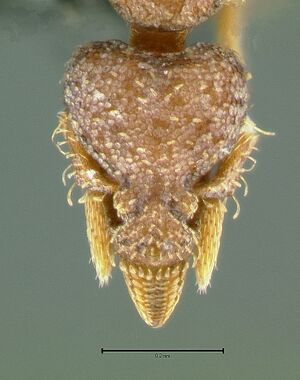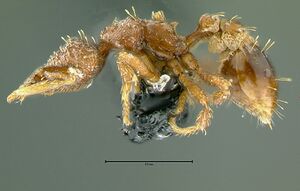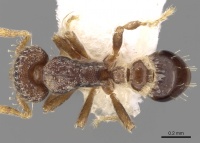Strumigenys karawajewi
| Strumigenys karawajewi | |
|---|---|

| |
| Scientific classification | |
| Kingdom: | Animalia |
| Phylum: | Arthropoda |
| Class: | Insecta |
| Order: | Hymenoptera |
| Family: | Formicidae |
| Subfamily: | Myrmicinae |
| Tribe: | Attini |
| Genus: | Strumigenys |
| Species: | S. karawajewi |
| Binomial name | |
| Strumigenys karawajewi Brown, 1948 | |
| Synonyms | |
| |
Widely distributed in the Malesian region, this is the only species of the capitata-group to have been found in Australia.
Identification
Bolton (2000) - A member of the Strumigenys capitata-group. S. karawajewi is closely related to Strumigenys dohertyi and shares a similar wide distribution. The two form a close species-pair characterised within the group by their possession of apicoscrobal and pronotal humeral (where they may be looped apically) flagellate hairs. The two are distinguished by the persistently small size of karawajewi (compare measurements), its possession of only a single pair of standing hairs on the mesonotal dorsum and its relatively slightly shorter scapes (SI 56-60 in karawajewi, SI 62-72 in dohertyi).
Keys including this Species
- Key to Australian Strumigenys Species
- Key to Micronesian Ants
- Key to Strumigenys of East Asia (as Pyramica)
Distribution
Latitudinal Distribution Pattern
Latitudinal Range: 14.16666698° to -13.9°.
| North Temperate |
North Subtropical |
Tropical | South Subtropical |
South Temperate |
- Source: AntMaps
Distribution based on Regional Taxon Lists
Afrotropical Region: United Republic of Tanzania.
Australasian Region: Australia.
Indo-Australian Region: Borneo, Indonesia (type locality), Malaysia, Micronesia (Federated States of), New Guinea, Palau, Philippines, Solomon Islands, Tonga.
Distribution based on AntMaps
Distribution based on AntWeb specimens
Check data from AntWeb
Countries Occupied
| Number of countries occupied by this species based on AntWiki Regional Taxon Lists. In general, fewer countries occupied indicates a narrower range, while more countries indicates a more widespread species. |

|
Estimated Abundance
| Relative abundance based on number of AntMaps records per species (this species within the purple bar). Fewer records (to the left) indicates a less abundant/encountered species while more records (to the right) indicates more abundant/encountered species. |

|
Biology
Brown (1964) - Smithistruma dubia (=Strumigenys karawajewi) is a New Guinea ant that has spread to certain Pacific island areas, possibly by way of human commerce. New Guinea, rain forest. From Western Samoa, north coast of Upolu, leaf litter and soil berlesate, rain forest.
Castes
Worker
  
| |
| . | Owned by Museum of Comparative Zoology. |
Nomenclature
- emeryi. Strumigenys (Cephaloxys) emeryi Karavaiev, 1935a: 106, fig. 25 (q.) INDONESIA (Sumatra). [Junior primary homonym of Strumigenys emeryi Mann, 1922: 37.] Replacement name: karawajewi Brown, 1948b: 44.
- karawajewi. Strumigenys (Trichoscapa) karawajewi Brown, 1948b: 44. Replacement name for emeryi Karavaiev, 1935a: 106. [Junior primary homonym of emeryi Mann, 1922: 37.] Combination in Smithistruma: Brown, 1948e: 105; in Trichoscapa: Brown, 1995: 219; in Pyramica: Bolton, 1999: 1673; in Strumigenys: Baroni Urbani & De Andrade, 2007: 122. Senior synonym of dubia: Brown, 1995: 219. See also: Brown, 1953g: 124; Bolton, 2000: 400.
- dubia. Smithistruma (Smithistruma) dubia Brown, 1953g: 122, pl. 1, fig. 13 (w.q.) PALAU IS. Junior synonym of karawajewi: Brown, 1995: 219.
Unless otherwise noted the text for the remainder of this section is reported from the publication that includes the original description.
Description
Bolton (2000) - TL 1.8-2.1, HL 0.46-0.52, HW 0.37-0.41, CI 79-83, ML 0.09-0.11, MI 20-23, SL 0.22-0.24, SI 56-60, PW 0.24-0.28, AL 0.48-0.53 (20 measured).
Apicoscrobal hair flagellate. Dorsum of head in profile with a transverse row of 4 standing hairs close to the occipital margin, and with a single pair of similar hairs just in front of the highest point of the vertex. Eye with 3-4 ommatidia in the longest row. Pronotal humeral hair flagellate or apically looped. Dorsum of mesonotum with a single pair of weakly remiform to feebly elongate-clavate stout standing hairs. Lamella of propodeal declivity narrow and inconspicuous. Petiole node in dorsal view as broad as or broader than long. Disc of postpetiole glassy smooth when clean (frequently with a waxy surface bloom present). First gastral tergite either with 3 transverse rows of standing hairs which are located basally, medially and apically, or with apical and basal transverse rows between which is a median pair of hairs, or with apical and basal transverse rows only.
Type Material
Bolton (2000) - Holotype queen, INDONESIA: Sumatra, Siak, Nr. 5414 (O. John) (Institute of Zoology of the Ukranian National Academy of Sciences) [examined].
- Smithistruma (Smithistruma) dubia: Holotype, worker, Garakayo L., Palau Islands, Palau Islands.
- Smithistruma (Smithistruma) dubia: Paratype, worker(s), queen(s), Garakayo L., Palau Islands, Palau Islands.
- Strumigenys (Cephaloxys) emeryi: Holotype, queen, Saik, Sumatra, Indonesia.
References
- Baroni Urbani, C. and de Andrade, M.L. 2007. The ant tribe Dacetini: limits and constituent genera, with descriptions of new species. Annali del Museo Civico di Storia Naturale “G. Doria”. 99:1-191.
- Bolton, B. 1999. Ant genera of the tribe Dacetonini (Hymenoptera: Formicidae). J. Nat. Hist. 3 33: 1639-1689 (page 1673, combination in Pyramica)
- Bolton, B. 2000. The ant tribe Dacetini. Memoirs of the American Entomological Institute. 65:1-1028. (page 400, redescription of worker)
- Brown, W. L., Jr. 1948b. Strumigenys karawajewi, new name for a Sumatran ant. Entomol. News 59: 44.
- Brown, W. L., Jr. 1948e. A preliminary generic revision of the higher Dacetini (Hymenoptera: Formicidae). Trans. Am. Entomol. Soc. 74: 101-129 (page 105, combination in Smithistruma (Smithistruma))
- Brown, W. L., Jr. 1953g. Revisionary studies in the ant tribe Dacetini. Am. Midl. Nat. 50: 1-137 (page 124, notes on queen)
- Brown, W. L., Jr. 1964b. The ant genus Smithistruma: a first supplement to the World revision (Hymenoptera: Formicidae). Trans. Am. Entomol. Soc. 89:183-200.
- Brown, W. L., Jr. 1995b [1994]. Trichoscapa karawajewi and its synonyms (Hymenoptera: Formicidae). Psyche (Camb.) 101: 219-220 (page 219, combination in Trichoscapa)
- Karavaiev, V. 1935a. Neue Ameisen aus dem Indo-Australischen Gebiet, nebst Revision einiger Formen. Treubia 15: 57-118 (page 106, fig. 25 queen described (junior primary homonym of Strumigenys emeryi Mann, 1922:37)
- Musfira, S.H., Rafi, M., Gusti, M., Putri, D.H., Satria, R. 2022. New data on the genus Strumigenys (Hymenoptera: Formicidae) from Sumatra. Zoosystematica Rossica 31(1): 74–86 (doi:10.31610/zsr/2022.31.1.74).
- Radchenko, A.G., Fisher, B.L., Esteves, F.A., Martynova, E.V., Bazhenova, T.N., Lasarenko, S.N. 2023. Ant type specimens (Hymenoptera, Formicidae) in the collection of Volodymyr Opanasovych Karawajew. Communication 1. Dorylinae, Poneromorpha and Pseudomyrmecinae. Zootaxa, 5244(1), 1–32 (doi:10.11646/zootaxa.5244.1.1).
- Shattuck, S. O. 1999. Australian ants. Their biology and identification. Collingwood, Victoria: CSIRO Publishing, xi + 226 pp. (page 170, see also)
References based on Global Ant Biodiversity Informatics
- Bolton, B. 2000. The Ant Tribe Dacetini. Memoirs of the American Entomological Institute 65
- Brown W. L. 1964. The ant genus Smithistruma: a first supplement to the world revision (Hymenoptera: Formicidae). Transactions of the American Entomological Society 89: 183-200.
- Brown W. L., Jr. 1948. Strumigenys karawajewi, new name for a Sumatran ant. Entomol. News 59: 44.
- Brown W. L., Jr. 1953. Revisionary studies in the ant tribe Dacetini. Am. Midl. Nat. 50: 1-137.
- Brown W. L., Jr. 1995. Trichoscapa karawajewi and its synonyms (Hymenoptera: Formicidae). Psyche (Camb.) 101: 219-220.
- CSIRO Collection
- Chapman, J. W., and Capco, S. R. 1951. Check list of the ants (Hymenoptera: Formicidae) of Asia. Monogr. Inst. Sci. Technol. Manila 1: 1-327
- Clouse R. M. 2007. The ants of Micronesia (Hymenoptera: Formicidae). Micronesica. 39: 171-295.
- Clouse, R.M. 2007. The ants of Micronesia (Hymenoptera: Formicidae), Micronesica 39(2): 171-295.
- Dlussky G.M. 1994. Zoogeography of southwestern Oceania. Zhivotnoe naselenie ostrovov Iugo-Zapadnoi Okeanii ekologo-geograficheskie issledovanii 48-93.
- Field Museum Collection, Chicago, Illinois (C. Moreau)
- Idechill O., R.H. Miller, K.S. Pike, and L.D. Hansen. 2007. Aphids (Hemiptera: Aphididae), ants (Hymenoptera: Formicidae) and associated flora of Palau with comparisons to other Pacific Islands. Micronesica 39(2): 141-171.
- Janda M., G. D. Alpert, M. L. Borowiec, E. P. Economo, P. Klimes, E. Sarnat, and S. O. Shattuck. 2011. Cheklist of ants described and recorded from New Guinea and associated islands. Available on http://www.newguineants.org/. Accessed on 24th Feb. 2011.
- Kami K.S., and S. E. Miller. 1998. Samoan insects and related arthropods: checklist and bibliography. Bishop Museum Technical Report 13, pp 121.
- Kami KS & Miller SE. 1998. Samoan insects and related arthropods: checklist and bibliography. Bishop Museum Technical Report No. 13.
- Karavaiev V. 1935. Neue Ameisen aus dem Indo-Australischen Gebiet, nebst Revision einiger Formen. Treubia 15: 57-118.
- Pfeiffer M.; Mezger, D.; Hosoishi, S.; Bakhtiar, E. Y.; Kohout, R. J. 2011. The Formicidae of Borneo (Insecta: Hymenoptera): a preliminary species list. Asian Myrmecology 4:9-58
- Snelling R. R. 1998. Insect Part 1: The social Hymenoptera. In Mack A. L. (Ed.) A Biological Assessment of the Lakekamu Basin, Papua New Guinea, RAP 9. 189 ppages
- Taylor R. W. 1976. The ants of Rennell and Bellona Islands. Natural History of Rennell Island, British Solomon Islands 7: 73-90.
- Wetterer, James K. 2002. Ants of Tonga. Pacific Science. 56.2: 125-135.
- Wilson E. O.; Taylor, R. W. 1967. The ants of Polynesia (Hymenoptera: Formicidae). Pacific Insects Monograph 14:1-109.
- Wilson E.O., and G.L. Hunt. 1967. Ant fauna of Futuna and Wallis islands, stepping stones to Polynesia. Pacific Insects 9(4): 563-584.
- Wilson EO, Hunt GL. 1967. Ant fauna of Futuna and Wallis Islands, stepping stones to Polynesia. Pacific Insects 9.4: 563-584.
- Wilson EO, Taylor RW. 1967. The ants of Polynesia. Pacific Insects Monograph 14:1-109.
- Wilson, Edward O. and George L. Hunt. 1967. Ant Fauna of Futuna and Wallis Islands, Stepping Stones To Polynesia. Pacific Insects. 9(4):563-584.
- Wilson, Edward O. and Hunt, George L. Jr. 1967. Ant Fauna of Futuna and Wallis Islands, Stepping Stones to Polynesia. Pacific Insects. 9(4):563-584
- Yamane S. 2013. A Review of the ant fauna of the Krakatau Islands, Indonesia. Bull. Kitakyushu Mus. Nat. Hist. Hum. Hist. Ser: A, 11: 1-66

